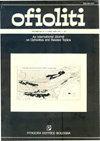Late Cretaceous arc and back-arc formation within the Southern Neotethys: whole-rock, trace element and Sr-Nd-Pb isotopic data from basaltic rocks of the Yüksekova Complex (Malatya- Elazığ, SE Turkey)
IF 1.3
4区 地球科学
Q2 GEOLOGY
引用次数: 30
Abstract
The remnants of the Southern Neotethys are represented by ophiolitic bodies and subduction/accretion complexes along the Southeast Anatolian-Zagros suture belt in the Eastern Mediterranean. Around Malatya and Elazig areas (SE Turkey), they are found within imbricated slices of a melange complex, known as the Yuksekova Complex. The studied basaltic rocks are common members of this melange complex, and show distinctive features of sources with tholeiitic to tholeiitic-transitional character. Petrography, whole-rock trace element and isotopic data reveal two different compositional groups. Group I is transitional between island arc tholeiites and normal mid-ocean ridge basalt, and Group II includes back-arc (BABB), enriched mid-ocean ridge (E-MORB), and ocean island basalt type (OIB) compositions. According to the known Late Cretaceous stratigraphic ages, the studied basaltic rocks have (87Sr/86Sr)i = 0.703666- 0.706394, (143Nd/144Nd)i = 0.512734-0.512927, 208Pb/204Pb = 38.3216-39.3400, 207Pb/204Pb = 15.5018-15.6262 and 206Pb/204Pb = 18.5655-19.3209. In addition, eNdi values vary between +3.99 and +8.01 with two-stage TDM values ranging from 0.25 to 0.59 Ga. In the Sr versus Nd isotope correlation diagram, most samples plot along the mantle array line. In the correlation diagrams of 206Pb/204Pb versus 208Pb/206Pb and 207Pb/206Pb, the rock samples also plot nearly on the Northern Hemisphere Reference Line, similar to Atlantic and Pacific Ocean ridge basalts. As a whole, the isotopic data reveal that the studied rocks were derived from a depleted mantle source. When plotted in the conventional tectonic discrimination diagrams based on immobile trace elements, the samples can be related to an arc environment (Group I basalts), and back arc basin (Group II basalts) developed by generation and maturation of the rifted arc in later stages. This interpretation is supported by ages obtained from pillow lava-radiolarian chert associations indicating that the arc stage was realized during the late Cenomanian-early Turonian, followed by Coniacian-early Maastrichtian spreading in a back arc basin within the closing southern branch of Neotethys.新特提斯南部晚白垩世弧和弧后形成:y ksekova杂岩(Malatya- Elazığ,土耳其东南部)的全岩、微量元素和Sr-Nd-Pb同位素数据
南新特提斯的残余以东地中海东南安纳托利亚-扎格罗斯缝合带的蛇绿岩体和俯冲/增生杂岩为代表。在Malatya和Elazig地区(土耳其东南部)周围,它们被发现在一个被称为Yuksekova complex的混合建筑群的砖砌切片中。所研究的玄武岩是该杂岩杂岩的共同组成部分,具有明显的拉斑岩-拉斑过渡性烃源岩特征。岩石学、全岩微量元素和同位素数据揭示了两种不同的成分组。第一类是岛弧拉斑岩与正常洋中脊玄武岩的过渡,第二类包括弧后(BABB)、富洋中脊(E-MORB)和洋岛玄武岩型(OIB)成分。根据已知的晚白垩世地层年龄,研究的玄武岩为(87Sr/86Sr)i = 0.703666 ~ 0.706394, (143Nd/144Nd)i = 0.512734 ~ 0.512927, 208Pb/204Pb = 38.3216 ~ 39.3400, 207Pb/204Pb = 15.5018 ~ 15.6262, 206Pb/204Pb = 18.5655 ~ 19.3209。此外,eNdi值在+3.99 ~ +8.01之间变化,两级TDM值在0.25 ~ 0.59 Ga之间变化。在Sr - Nd同位素对比图中,大多数样品沿地幔阵列线绘制。在206Pb/204Pb与208Pb/206Pb和207Pb/206Pb对比图中,岩石样品也接近北半球参考线,与大西洋和太平洋脊玄武岩相似。总体而言,同位素数据表明所研究的岩石来自枯竭的地幔源。在常规的基于不动微量元素的构造判别图中,这些样品与后期裂陷弧的生成和成熟所形成的弧后盆地(II组玄武岩)和弧后环境(I组玄武岩)有关。从枕状熔岩-放射虫岩组合得到的年龄支持了这一解释,表明弧期是在塞诺曼晚期-土鲁宁早期实现的,随后是在新特提斯闭合南支内的弧后盆地内的coniian -early Maastrichtian扩张。
本文章由计算机程序翻译,如有差异,请以英文原文为准。
求助全文
约1分钟内获得全文
求助全文
来源期刊

Ofioliti
地学-地质学
CiteScore
2.40
自引率
7.70%
发文量
1
期刊介绍:
Since 1976, Ofioliti provides an international forum for original contributions and reviews in the field of the geodynamics, petrology, geochemistry, biostratigraphy, stratigraphy, tectonics and paleogeography applied to ophiolitic terrains and modern oceanic lithosphere, including their sedimentary cover. Studies of topics such as geodynamics of the mantle, the evolution of orogens including ophiolites and paleoceanography are also welcome
 求助内容:
求助内容: 应助结果提醒方式:
应助结果提醒方式:


